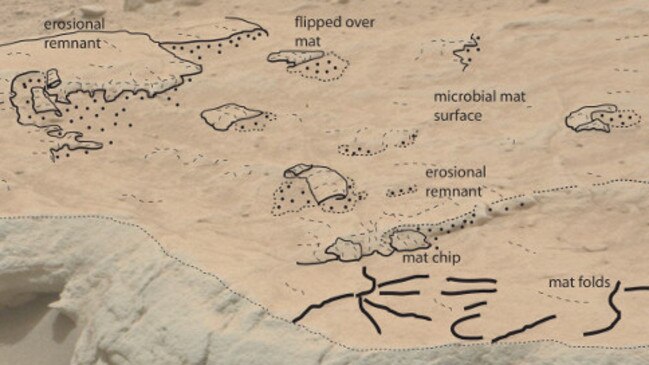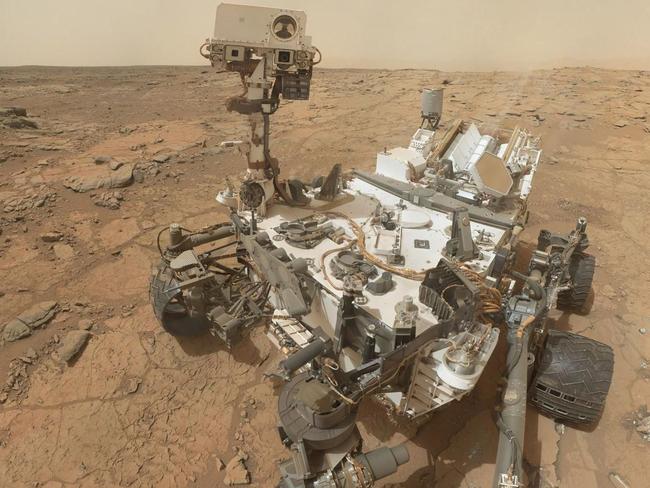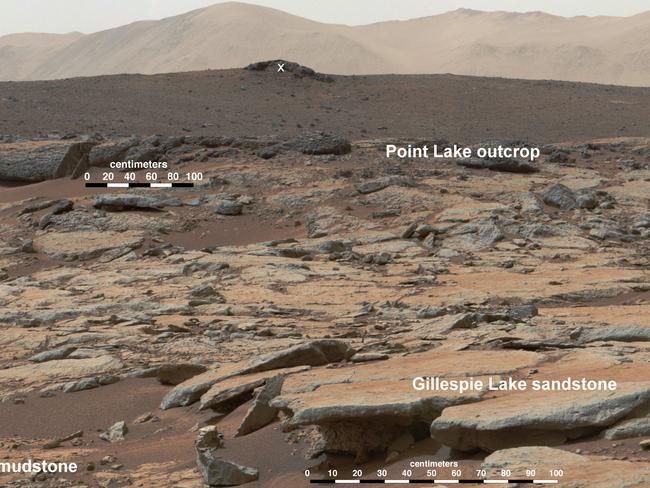Mars microbe ‘footprints’ may have been spotted on the surface of rocks
A FEW squiggles, cracks and lumps found by the Curiosity Rover on a large Mars rock has scientists on the edge of their seats: Are these the fossilised ‘footprints’ of life?

A FEW squiggles, cracks and lumps found by the Curiosity Rover on a large Mars rock has scientists on the edge of their seats: Are these the fossilised ‘footprints’ of life?
A study published in the journal Astrobiology this week poses the tantalising question after comparing the prominent sedimentary rock with similar formations found on Earth.
Here, geologists would instantly recognise the impressions as being the structures and shapes left by carpets of microbes that colonise drying lakebeds.
RELATED: Kepler telescope finds ‘most Earth-like’ planet yet
Similar signs were used last year to date the oldest known life on Earth — in 3.48 billion-year-old rocks on the West Australan Dresser Formation.
On Mars, science has to be somewhat more cautious — until they find the microbes themselves.
The photograph was taken by the NASA Curiosity Mars rover when it drove through a region dubbed the Gillespie Lake outcrop — an area believed to be a dry lake bed that last flooded billions of years ago when the Red planet was a warmer and wetter world.
“All I can say is, here’s my hypothesis and here’s all the evidence that I have,” the study author says, “although I do think that this evidence is a lot.”


Sediment structures
Study author Nora Noffke of Old Dominion University in Virginia is an expert in such fossilised traces of microbial life.
The geobioligist has pointed out striking similarities between the Mars formation and those known to contain traces of fossilised microbe colonies here.
It’s all about the bumps, lumps, chips and cracks in the rock.
Under forensic examination, they can tell us much more than just how the rock is weathering.
The way the thick tufts of microbial “carpet” compact the sediments follows patterns. These can then be preserved as the soft mud gradually hardens into rock — creating differences in density that can become exposed as sand and wind erodes the surface away.
STAR WARS: 14 ‘Death Stars’ have been detected heading our way
Such patterns also can tell a lot about the environment in which they were formed.
Microbial mats in rivers are pushed into different shapes to their sprawling lake-bed cousins, for example.
Noffke writes: “If the Martian structures aren’t of biological origin then the similarities in morphology, but also in distribution patterns with regards to MISS on Earth would be an extraordinary coincidence.”

Careful analysis
Seeing patterns in Mars rocks is nothing new.
People have been reporting bones, ancient petroglyphs, aliens — even mice — in Mars rover photographs for years.
But this example has made its way into a scientific journal because of the many careful comparisons between what is seen on Mars with many similar structures in Germany, the United States and Tunisia — as well as Western Australia’s Dresser Formation and Carbla Point.
RELATED: Is this Mars rock evidence of aliens?
But Noffke admits the only way to confirm her hypothesis is to get a sample back to Earth.
Confirming such rocks on Earth are evidence of microbe formation involves cutting them into ultra-thin slices and carefully mapping the structures under microscopes.
Until then, the only option is for the Curiosity Rover to examine what organic or chemical traces it can find when and if it stumbles across such a rock again.
NASA planetary scientist Chris McKay told astrobio.net that the chances of such traces remaining after billions of years is very low.
“These are just ancient sedimentary structures, and biology has long since left,” he says.
“A sample return mission would be the gold standard. But that’s just unlikely to happen anytime soon.”





